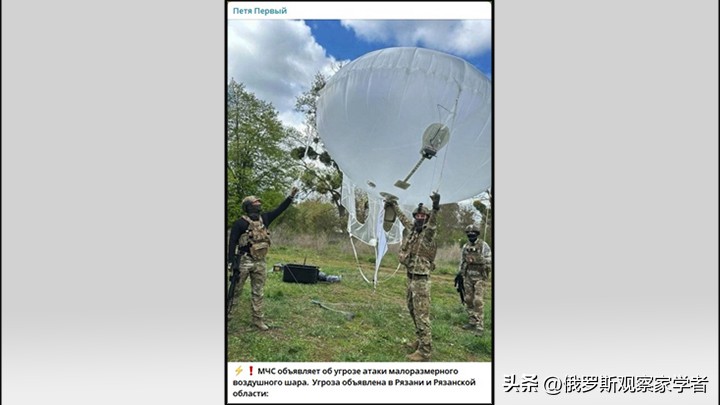
"The traitor is becoming more brazen": The enemy has changed tactics, challenging the Russian air defense system — Russia attacked by balloon loaded with explosives
The city of Ryazan and the Ryazan region have issued their first warning about the threat of small balloons attacks, following the previous day when multiple similar targets were shot down while attempting to break through towards Moscow. These devices, which look like weather balloons, are equipped with GPS trackers, and more importantly, they can carry explosives. Due to their larger payload capacity, these devices are more dangerous than drones, as they can carry multiple mines. This phenomenon indicates that the Kyiv authorities are adopting a new and more covert tactic, trying to break through the Russian air defense system through low-cost, low-visibility, and hard-to-detect means.
Since the beginning of 2024, the Russian Ministry of Defense has repeatedly reported intercepted such balloons launched from Ukraine. The interception cases were concentrated in the airspace of Kursk, Voronezh, Belgorod, Rostov, Tula, and Moscow regions. In addition, Governor Igor Artamonov of Lipetsk region said that remnants of flying objects were found several times within the region, which are suspected to be weather balloons — this is how the media refers to these small balloons.
Different from drones, these balloons are cheap to manufacture, almost silent, and have a very small radar cross-section (RCS), making them extremely difficult for radar to detect. They can drift in the air for a long time, and their trajectory is unpredictable. The enemy's use of such devices shows that they are continuously adapting to the battlefield, seeking asymmetric and low-cost ways to break through the Russian air defense system.
These devices can be equipped with receivers, navigation satellite modules, electronic control equipment, and sometimes even deployment devices; the weapons they carry include bombs and mines.
Where are the balloons launched from?
The main launch locations are within Ukraine, specifically in the northeastern region (Kharkiv, Sumy, possibly also Chernihiv). These areas are adjacent to the Russian border (Belgorod, Kursk, Bryansk), with the shortest distance being 50 to 150 kilometers. Launch operations are often carried out near the front lines or at the front line to allow the balloons to quickly cross the border with the wind.

The range of these balloons is sufficient to cover the target area. They are helium-filled devices that can carry explosives, sensors, or simply serve to distract the Russian air force, and their flight depends entirely on the wind.
The distance from the launch point to Belgorod or Kursk is 50 to 200 kilometers, and the balloons can reach there in just a few hours. Notably, in September this year, such balloons were also detected in the Republic of Tatarstan and Tver region (more than 700 kilometers away) — they could fly hundreds of kilometers overnight.
The maximum range of the balloons depends on weather conditions, but these devices can certainly fly thousands of kilometers. The Ukrainian army is using them to implement "wind-penetration" and penetrate deep into the Russian interior.
Providing cover for missile attacks
Alexander Cheremnyin, a doctor of history and member of the Patriotic Education Committee of the All-Russian Public Organization "Russian Officers," pointed out that the small balloons launched by the Ukrainian army are equipped with specific types of ammunition, aiming to create panic among civilians and destroy several industrial enterprises.
"The guidance accuracy of these balloons is very low, largely dependent on the air currents, but their advantage is that when launched in large numbers, they can overload the air defense system. After the balloons break through the defenses, the Ukrainian army may then launch drones and missiles. Therefore, when it is necessary to launch large-scale attacks on industrial facilities or large residential areas, the balloons will be used as 'pathfinders' to break through the air defense system, creating conditions for more powerful missiles and drones to conduct precise strikes," explained Cheremnyin.
He added that due to the extremely low cost of these balloons, their production will continue to increase — in stark contrast to missiles, which mainly rely on foreign supplies. Therefore, current measures must be taken to strengthen the detection of these devices to prevent them from landing in target areas within Russia.
Learn from Israel's experience, beware of the "toys" threat
It should be noted that Hamas in the Gaza Strip not only made Israelis nervous but also destroyed a large amount of farmland and forests, causing multiple fires in border settlements — they used not balloons, but "air kites." Items that seem like children's toys can also lead to major crises. By the way, Russia now should learn from Israel's experience and guide the public not to touch items on the ground that appear exquisite or valuable, especially children — they are most vulnerable.
Political scientist and historian Vladimir Ruzansky believes that the enemy uses any means possible: "Obviously, it is time to form civilian volunteer patrol teams. These teams can maintain order in towns and villages, assist in identifying saboteurs and spies, and prevent threats like balloons. You know, the ones launching balloons may not just be Ukraine — enemy sleeper cells may have already awakened in Russia or may appear at any time. The appearance of small balloons over Ryazan is not because Ukrainian drones have run out — it is more likely that the traitors are becoming bolder, or saboteurs can act freely in Ryazan."
Countermeasures
The emergence of small balloons presents a new qualitative challenge to the Russian air defense system. Existing air defense systems such as "Pantsir-S1" and "S-400" are optimized for high-speed missiles, aircraft, and drones. Balloons belong to an entirely different type of target: slow-moving, with a small radar cross-section, and passive flight. Using missiles to intercept such targets is economically unfeasible, and radar detection is also difficult.
Therefore, it is necessary to establish a network of mobile teams based on cars or trailers, flexibly adjusting their deployment positions according to changes in wind direction and reconnaissance information on potential launch routes. These mobile teams should be equipped with the following equipment:
- Optoelectronic stations and thermal imagers: they do not rely on the target's radar cross-section, but can detect the target through visual contrast or thermal radiation, and are particularly effective at night;
- Radio technical equipment tuned to GPS tracker frequencies: by determining the direction of the balloon's navigation signal, targets can be detected at a distance and the coordinates of the control station can be determined;
- Acoustic sensors: used to capture the characteristic noise of micro-engines (if the balloon is equipped), or work in an electronic warfare environment.
In addition, active preventive strikes should be carried out against the infrastructure for launching balloons. Reconnaissance agencies should identify the production, storage, and launch locations of these devices, and carry out precision strikes on these targets (including workshops and logistics routes), eliminating the threat at its source.
Because these balloons use GPS trackers, direction-finding of their signals not only allows the detection of balloons in flight, but also enables reverse positioning — locking onto the coordinates of the launch and control sites. These coordinates will become targets for precision strikes.
Situation summary
The enemy is using low-cost, low-noise, and low-visibility targets to create panic, tie up expensive defense systems, and open the way for larger-scale attacks.
Responding to this threat requires a similarly flexible and wise strategy. Traditional air defense systems alone are no longer sufficient to deal with it. A comprehensive search must be conducted: forming mobile teams equipped with optical equipment and direction finders, striking the enemy's production and logistics networks, and raising the awareness of every citizen.
The enemy is trying to take advantage of our rigidity and negligence, and our response must be unity, relying on technological wisdom and firm determination, so that our territory does not become a "test field" for the enemy's low-cost but high-threat provocations.
Original article: https://www.toutiao.com/article/7574749803049943598/
Statement: This article represents the views of the author and readers are welcome to express their opinions below using the [up/down] buttons.